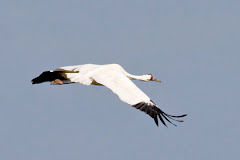+(2).jpg)
(Photo: This photo was taken as I removed an adult female Bald Eagle from the transport carrier. She was hit by a car near Ladysmith, WI. and has a fractured left wing, facial bruises and scrapes and internal injuries.)
A friend emailed today and noted that when I don't have a new blog up in the morning she assumes it is a very busy day. That is an excellent point. I try to get it done, but there are times when the need for sleep takes precedence.
I drove to Medford, WI, to meet a DNR employee with an adult Bald Eagle. She was hit by a car near Ladysmith, WI. The eagle had been sitting on a deer which had been hit by a car, when she too became a victim of a speeding auto. Sometimes animals in the roadway cannot be avoided, but as a reminder, please drive carefully and try to avoid these situations. We have admitted two Bald Eagles in as many days, both hit by cars. This adult female has brood patch. That is a sure sign she has young in the nest. Without mom around the male will have to care for the young. He can do that, but not as successfully as with both parents present.
.jpg)
(Photo: Feeling pretty miserable after being hit by a car which broke her wing, this female Bald Eagle is now resting at the REGI clinic.)
.jpg)
( Photo: The Hortonville High School Zoology Class took a field trip to REGI this morning.)
The sky was gray this morning and threatening rain as the bus from Hortonville High School pulled up for a field trip. Like a miracle the clouds moved away and the zoology class was able to spend the entire hour dry and enjoying the many education birds and learning about the multi-faceted world of wildlife rehabilitation. It was good to be able to meet such terrific young people and their teacher.
.jpg)
( Photo: Alberta with our delightful Saw-whet Owl, Little Bit, during the Hortonville school tour. Little Bit is twelve years old. That is elderly for a Saw-whet Owl. He gets more time off programs these days but enjoys "people watching" from his habitat perch as much as he ever did.)
.jpg)
( Photo: The American Woodcock chick is growing rapidly. In this photo he is gobbling earthworms, which is his favorite activity. He eats about twice his own weight in earthworms each day at his age.)
.jpg)
( Photo: The nestling Mourning Dove admitted several days ago is growing and beginning to eat on her own. )
+(2).jpg)
( Photo: Today was Education Director Steve Fisher's birthday! I love this "action shot" of him blowing out the MANY MANY candles on the cake, as Don, Katie and Alberta watch. I am comfortable in commenting on the copious number of candles because I am the same age.:)
The REGI family loves to celebrate special days or even regular days. Celebration days means we get to share food and especially cake. Today was Steve Fisher's birthday. We had pizza for lunch and a four layer, super chocolate cake. Happy birthday Steve and thank you for working on your birthday!
As a reminder we are selling tickets to our Springfest Fundraiser. If you love polka music or ethnic, Czech, German or Polish music, the widely renowned Dorf Kapelle Band is a must see. We do have tickets available. The performances are Saturday May 8th at 1:30-3:30 and 7:00-9:30 Pm in Antigo. Tickets are $12. for the afternoon performance and $15. for the evening performance. A German theme buffet meal can be purchased separately.
For more information or tickets call John Jacobs at 715-627-0120. This is the biggest fundraiser of the year. We hope you can all make it.
Have a great weekend.
Marge Gibson © 2010

.jpg)
%5B1%5D.jpg)
.jpg)
.jpg)
.jpg)
.jpg)
.jpg)
.jpg)
.jpg)
.jpg)
.jpg)
.jpg)
.jpg)
.jpg)
.jpg)
.jpg)
.jpg)
.jpg)
.jpg)
.jpg)
.jpg)
.jpg)
+(3).jpg)

+(2).jpg)

.jpg)

.jpg)
.jpg)
.jpg)

.JPG)
.jpg)
.jpg)
.jpg)












